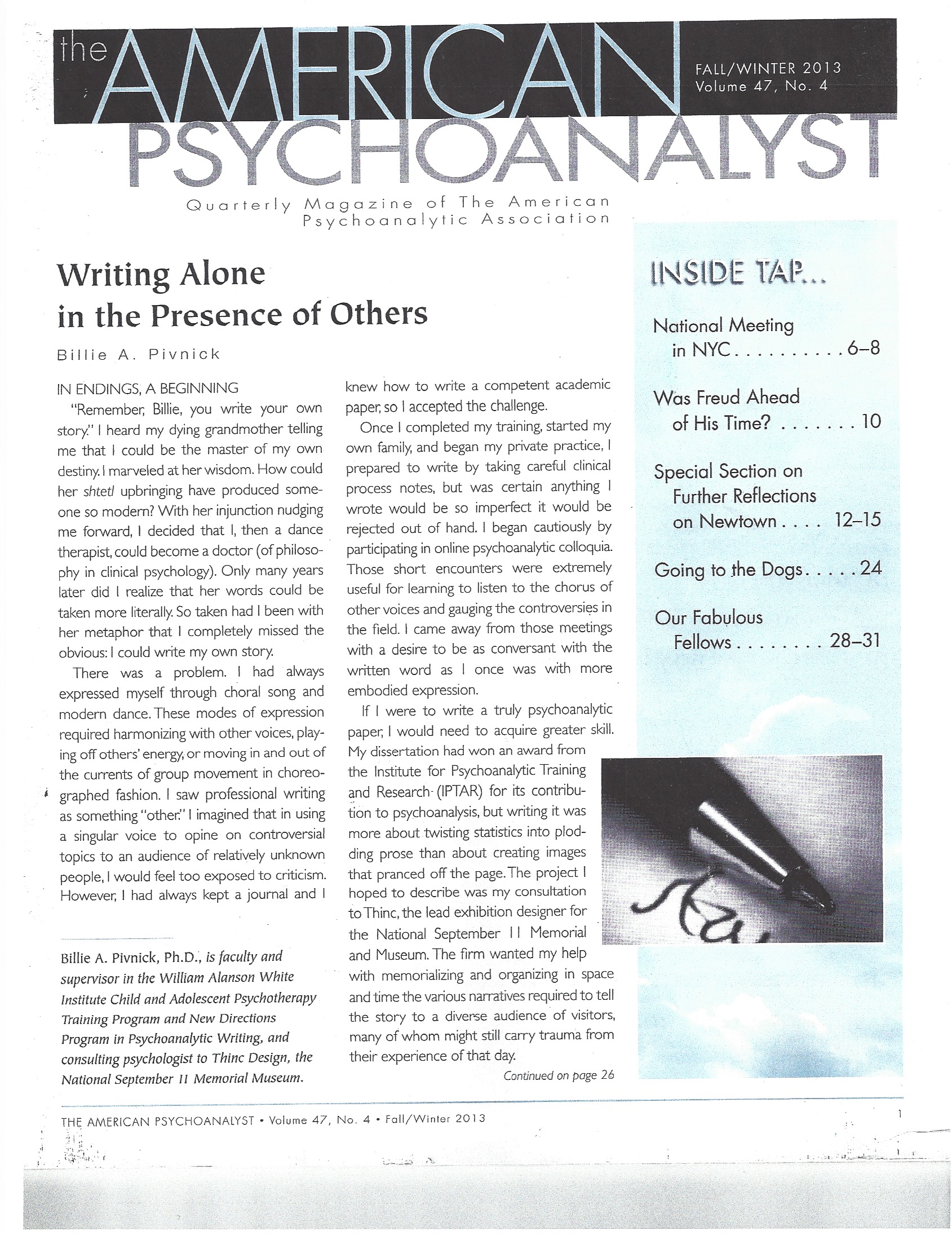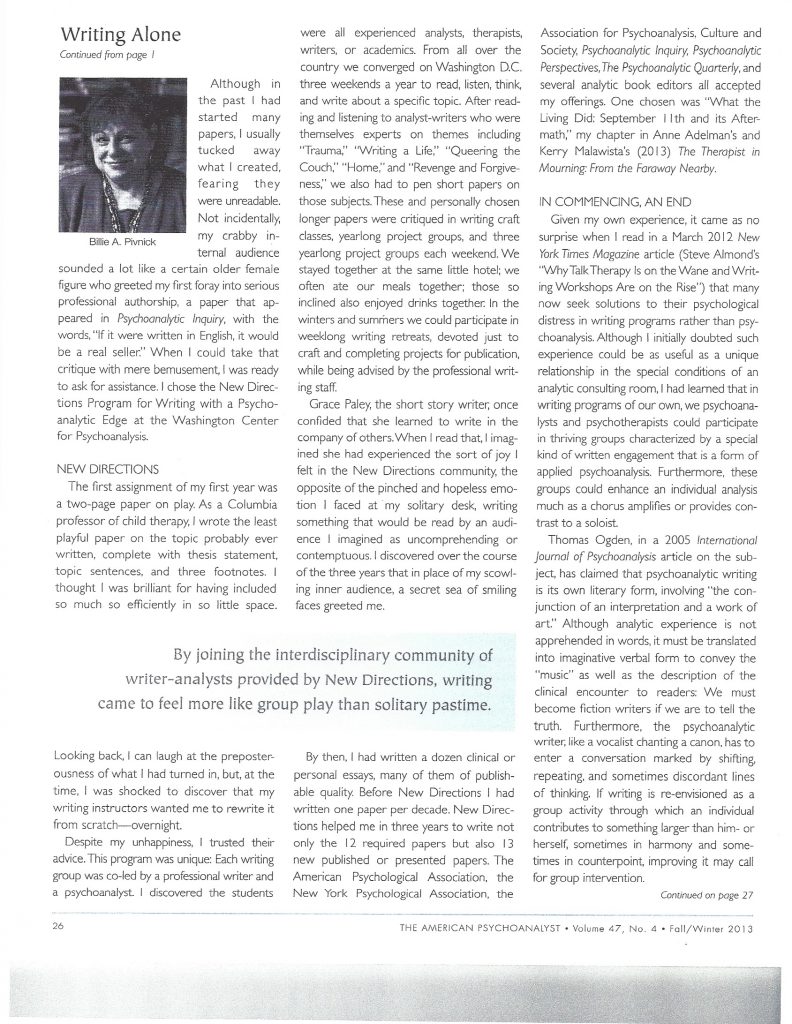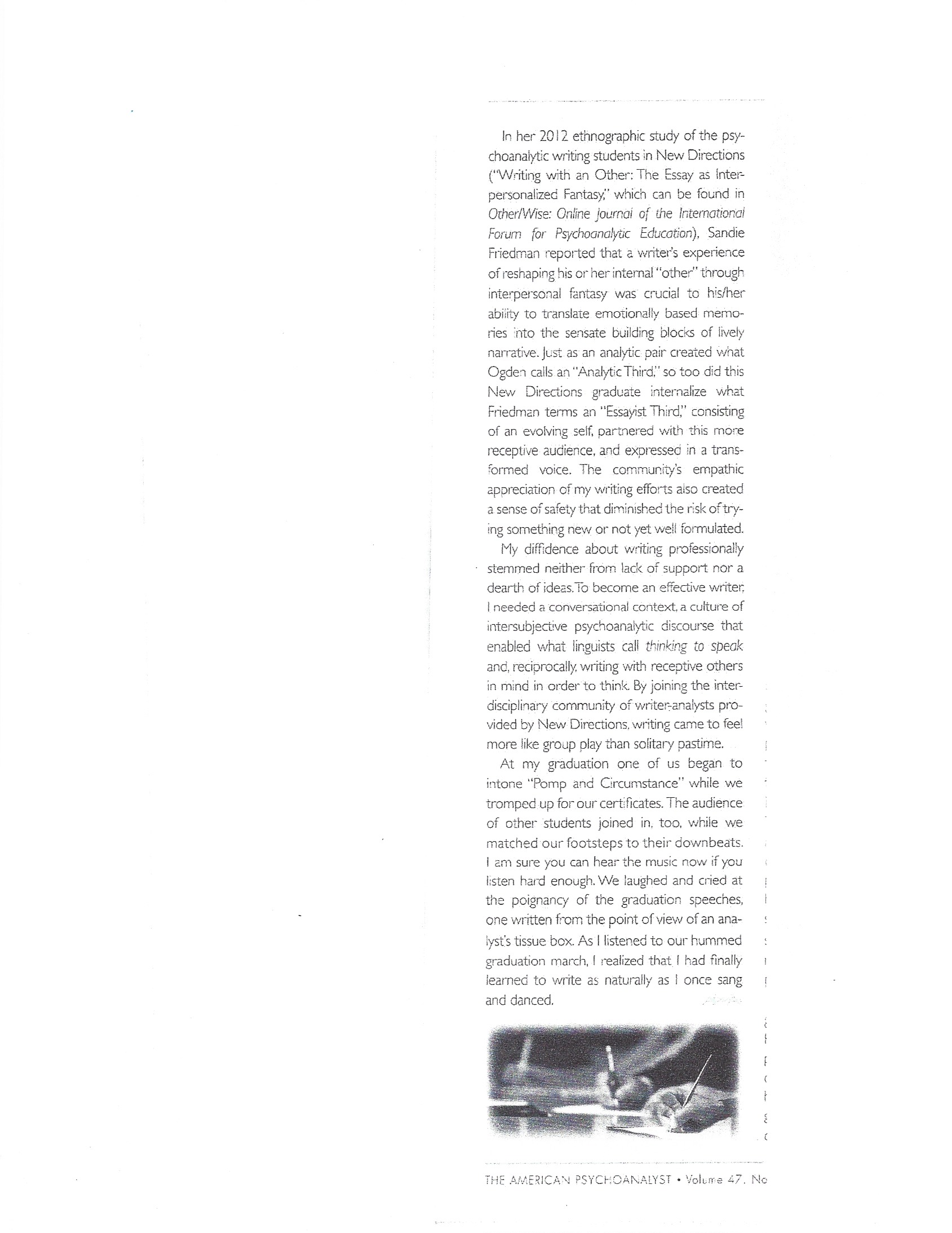Reflections
Using Psychoanalytic Insights in Memorializing 9/11
Billie Pivnick—Psychologist/Psychoanalyst
The National September 11 Memorial & Museum was created with a “relational design.” Exhibition designer Tom Hennes of Thinc Design partnered with the National September 11 Memorial & Museum and sought my services as a psychoanalyst in planning the museum. He wanted to avoid re-traumatizing visitors, and his prior experience designing the South African Freedom Park during the Truth and Reconciliation process showed him how trauma’s disruption of narrative coherence could wreak havoc on a memorial design process.
Even as we began our work, some five years after September 11, 2001, U.S. politics had become so polarized as to jeopardize our country’s democratic functioning. While there were many explanations for our political impasse, one of them certainly was the effect of mass catastrophic trauma on our ability to express and regulate ourselves.
Freud famously described the collapse in time that follows traumatic anxiety. What we witnessed following 9/11 were five interwoven kinds of collapse: physical, narrative, symbolic, temporal, and intersubjective. Both buildings and bravado crumbled. Our capacity to tell our individual and collective stories fell victim to the many gaps in our understanding of what had happened. Even multiple viewings of the repeating images of our shocking new reality failed to yield consensual interpretations. Reciprocal relations in our governing institutions were blocked like gridlocked cars in a jammed intersection.
Psychoanalyst John Kafka in an article on psychoanalysis and democracy that appeared in American Imago in 2008, identified the dangers for political systems of radical breaks in time caused by mass trauma. The community’s memories were not just interrupted in these instances, but broken irreparably. In the aftermath, despite attempts to mend, society often engaged in seemingly rational debates that contained unconscious irrationality. For instance, when trying to remember the past without examining what had been unconsciously omitted or overemphasized, we could re-traumatize ourselves rather than heal wounds. In these instances, memory conservation could be hijacked to serve demagogic purposes.
Could museum designers use a psychoanalytic approach to engage with this kind of altered social reality? In the aftermath of 9/11, memorialization was called for in order to repair “the social link” (Francoise Davoine and Jean-Max Gaudilliere, History Beyond Trauma: Whereof One Cannot Speak, Thereof One Cannot Stay Silent, 2004, 13). Our memorial museum design drew on a relational aesthetics to evoke engagement among visitors to the museum.
Whether the arts are employed to bring together polarized groups or to disorient the overly complacent, they are creating what a critic calls relational aesthetics, artistic practices which consider the entirety of human relations and their social context (Nicolas Bourriaud, Relational Aesthetics, 2002). A relational artist may catalyze a social environment in a museum or gallery to provoke visitors to learn about themselves. In a museum that commemorates a significant historical event—a memorial museum—people are brought together so they can encounter others’ perspectives with the hope that the museum can aid in fostering understanding, even between antagonistic groups. Exhibition designers aim to make visitors care about the curator-assembled narratives and materials. They do so in how they display historical artifacts, film footage, audio recordings, or the names, images, and photos of those who died. While standing in the spaces provided by the museum, visitors are encouraged to reflect on meanings they have attributed to the events being commemorated and to consider new perspectives; they are also encouraged to notice the reactions of other visitors.
While art and design are quite different things, they share a use of visual, auditory, rhythmic, and spatial dimensions to symbolize emotional experience. Like art, design is in the eye of both the beholder and the design/curatorial teams which constitute, together with the visitors, an intersubjective unit. Furthermore, both occupy the realm of culture.
Cultural experience, according to psychoanalyst Donald Winnicott (Playing with Reality, 1991), grows out of theability to play and to create potential space. Politics, economics, philosophy, and culture belong to this third area of experience, the intersubjectivity beyond dependence and independence.
This third zone is also a crucible for the arousal-modulating state management that unfolds between two individuals, according to Daniel Stern (Forms of Vitality, 2010). Reciprocal state-sharing and affect attunement constitute nascent relationships as well as developing aesthetic forms. Arousal switches on thought, emotion, perception, and movement to animate our life experience by creating the force, timing, shape, and directional intent of movement. Together, these emergent properties enhance perceptual experience and stimulate spontaneous interaction.
The same mechanisms that shape our experience of arousal in infancy underpin our responses to the temporal arts ofmusic, dance, cinema, theater – and museum visits. Since matching vitality forms with an “Other” creates what Stern calls “a running dialogue” with that person’s other emotional behaviors, learning others’ emotional meanings through being exposed to their artistic forms can help us predict their behavior, diminishing mistrust.
Studies have confirmed that contact among opposing groups diminishes conflict, whether or not agreement is reached. In peace negotiations, warring groups are typically asked to sit face to face. In South Africa, the Truth and Reconciliation process ideally involves facing one’s victim or perpetrator while bearing witness to the truth of what happened and moving together gradually toward reconciliation. In the reconciliation process following the Rwandan genocide, to promote empathy perpetrators of violence are required to perform active service to their victims, thus more deeply feeling the victims’ concerns.
When the arts are employed to enhance a reconciliation process, diverse groups view one another’s art, listen to one another’s music, and watch one another’s dances. In one instance, documented in a 2012 film, Sweet Dreams, directed by Lisa and Rob Fruchtman, both perpetrators and victims of the Rwandan massacre were brought together by a theater director, who helped them form into a drumming group. Over time, as they matched one another’s rhythms, they learned to listen to each other’s stories, too. Together they remembered nearly unbearable sorrows and losses. Eventually, they were able to work together well enough to open and successfully run a novel business.
Here in the U.S., though, 15 years have passed since 9/11, and even psychoanalytically-informed memorialization has only grazed the surface of our maladies. Although the museum was judged to have achieved its aims, outside its confines demagogic politics are in full swing during this run-up to the 2016 election, not only because of traumatic processes, but also due to massive economic dislocation and incipient climate change.
Social groups and systems appear to have responded to pervasive and continual annihilation anxiety and perceived leadership failure by becoming less cohesive—either massing and looking for a strong leader to identify with, or fragmenting into individuals isolated and alienated from one another – at the extreme, lone wolf terrorists. Anomie, an alienated normlessness that is a consequence of social disruption and reorganization, is everywhere in evidence. At the polarities, either repetitive, stereotypic, or unhinged communication manifested, or its opposite, rhetoric obeying a single ideology, impinged on private experience.
Psychoanalytic memorialization contributed to enacting remembrance. During the museum design process, I often sat in on the design team’s internal meetings. Occasionally, someone would do or say something that revealed or enacted a strong emotion that we had unconsciously left out of the museum’s narrative to shield visitors and ourselves from becoming too overwhelmed. Once recognized, such affects were incorporated into the museum narrative.
However, could a psychoanalytic perspective also address our post-9/11 dysfunctional communication and political process? The scope of this museum design project was necessarily limited; multiple individual design, curatorial, and political perspectives jostled one another in a way that tended to keep the focus narrow. Nevertheless, I wonder if we sufficiently explored the effect of the attackers’ hatred, our wishes to retaliate or identify with the aggressor, feelings of some that we were left unprotected, or explicitly enough called for renewed ethical intersubjectivity and empathic interconnectedness. These themes repeatedly re-surfaced during primary election debates.
Although a museum is not psychotherapeutic, and the world is not our patient, we anticipated that the museum experience would catalyze a political conversation “protected-enough” from toxicity to form a relational home for soothing annihilation anxiety stirred up by ongoing terrorist activity (Robert Stolorow, World, Affectivity, Trauma, 2002). We also hoped that the psychoanalytically-informed memorialization process we began in our design and narrative could continue outside of the “safe-enough” confines of the museum.
Billie Pivnick, PhD, a psychoanalytic psychologist in New York City, is on the faculties of the William Alanson White Institute and Columbia University. Her related work includes the Schillinger Award Essay, “Spaces To Stand In: Applying Clinical Psychoanalysis To the Relational Design of the National September 11 Memorial Museum,” in Division/Review (Fall, 2015), “Enacting Remembrance: Turning to Memorializing September 11th” in Journal of Religion & Health (2011), and with Tom Hennes, “Managing Collapse: Memorializing September 11th Through The Co-creation of a Memorial Museum.” In Michael O’Loughlin, (Ed.). The Ethics of Remembering and the Consequences of Forgetting: Essays on Trauma, History and Memory (2014). She may be contacted at drbilliepivnick@gmail.com. ❑


